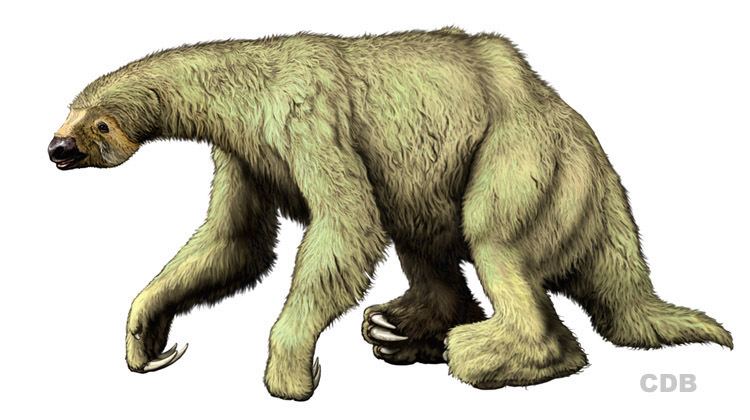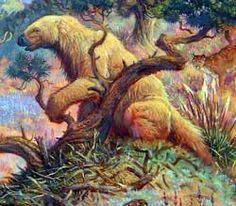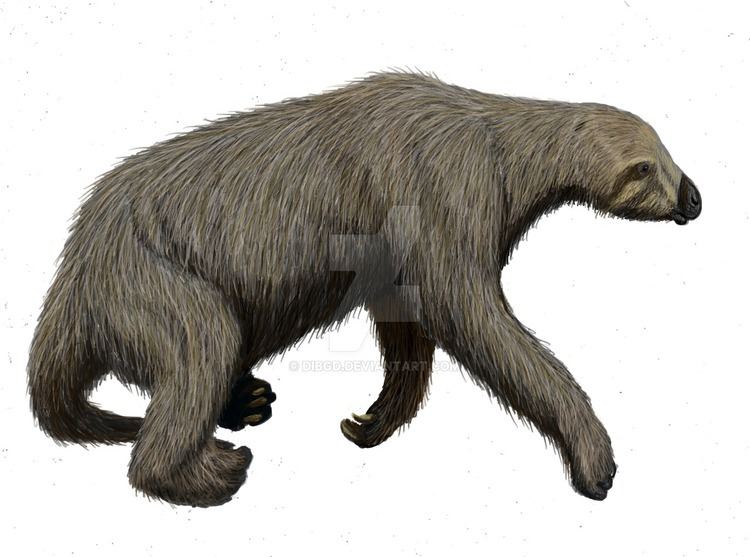Rank Genus | Phylum Chordata Order Xenarthra | |
 | ||
Similar Nothrotheriidae, Paramylodon, Megalonyx, Megatheriidae, Eremotherium | ||
Cbeebies andy s prehistoric adventures nothrotheriops
Nothrotheriops is a genus of Pleistocene ground sloth found in North America, from what is now central Mexico to the southern United States. This genus of bear-sized xenarthran was related to the much larger, and far more famous Megatherium, although it has recently been placed in a different family, Nothrotheriidae. The most well known species, N. shastensis, is also called the Shasta ground sloth.
Contents
- Cbeebies andy s prehistoric adventures nothrotheriops
- Nothrotheriops sounds
- Discovery and species
- Ecology
- Fossil and geographic range
- In popular culture
- References

Nothrotheriops sounds
Discovery and species

Fossils of the best-known species, the Shasta ground sloth (N. shastensis), have been found throughout western North America, especially in the American Southwest. It is the ground sloth found in greatest abundance at the La Brea Tar Pits. The most famous specimen was recovered from a lava tube at Aden Crater in New Mexico and was found to still have hair and tendon preserved. This nearly complete specimen is on display at the Yale Peabody Museum of Natural History in New Haven, Connecticut. Numerous dung boluses belonging to Nothrotheriops have also been found throughout the southwestern United States and have provided an insight into the diet of these extinct animals.

Although N. shastensis was one of the smallest ground sloth species, it still reached 2.75 metres (9.0 ft) from snout to tail tip and weighed 250 kilograms (551 lb) (one-quarter of a tonne) - much smaller than some of its contemporary species such as the Eremotherium, which could easily weigh over two tonnes and be 6 metres (20 ft) long. It had large, stout hindlegs and a powerful, muscular tail that it used to form a supporting tripod whenever it shifted from a quadrupedal stance to a bipedal one (i.e. Eremotherium).
Ecology
Nothrotheriops behaved like all typical ground sloths of North and South America, feeding on various plants like the desert globemallow, cacti, and yucca. It was hunted by various local predators, like Smilodon, from which the sloths may have defended themselves by standing upright on hindlegs and tail and swiping with their long foreclaws, like its distant relative Megatherium, as conjectured in the BBC series Walking with Beasts. The same claws could also been used as tools to reach past the plant spines and grab softer flowers and fruits. Also, the Shasta ground sloth may have had a prehensile tongue (like a giraffe) to strip leaves off branches.
The Shasta ground sloth is believed to have played an important role in the dispersal of Yucca brevifolia, or Joshua tree, seeds. Preserved dung belonging to the sloth has been found to contain Joshua tree leaves and seeds, confirming that they fed on the trees. It has been suggested that the lack of Shasta ground sloths helping to disperse the seeds to more favourable climates is causing the trees to suffer.
Fossil and geographic range
This genus's lineage dates back to the Miocene. The ancestors of Nothrotheriops migrated to North America from South America as part of the Great American Interchange during the Blancan, about 2.6 MYA. A fossil find had been described from as far north as the Canadian province of Alberta; however, this report is believed to have been mistaken. The genus lived primarily in the southwestern region of the U.S., from the states of Texas and Oklahoma to California; it has also been found in Florida.
The best known historical specimen was found in a lava tube at Aden Crater in New Mexico; it was found with hair and tendon still preserved. Rampart Cave, in the Grand Canyon, Arizona, has a plentiful amount of the sloth's hair and dung, which allowed the scientists both to use radiocarbon dating techniques to establish when it lived. The most recent credible dates from this and each of about half a dozen other southwestern caves are about 11,000 BP (13,000 cal BP).
In popular culture
The Shasta ground sloth has appeared in the documentary Wild New World and Titans of the Ice Age. In 2014 it was featured in the first episode of the BBC Two documentary series Ice Age Giants, in which its dung, preserved since the last Ice Age, was examined.
